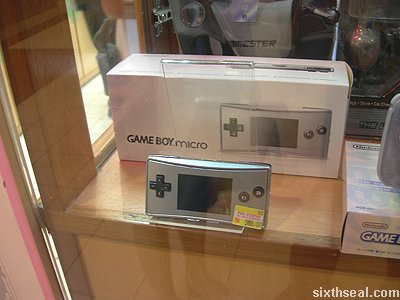
Nintendo came out with the Game Boy micro as a revamp of the Game Boy Advance SP system with the tagline “smaller. sleeker. brighter.”. It takes in Game Boy Advance SP cartridges and the Game Boy micro is one small and sleek unit, which prompted me to purchase it. I bought it bundled with a game for RM 410 – I chose Need for Speed: Most Wanted for the GBA.
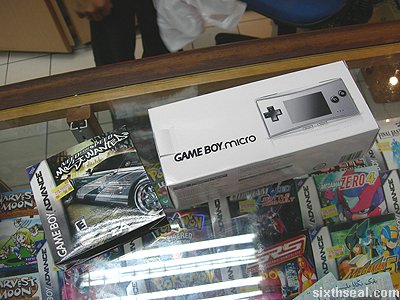
The Game Boy micro retails for RM 380 (stock) and it’s marketed towards the iPod generation with its sleek design. It’s very small – just slightly larger than the cartridges it accepts. You’ll be hard pressed to imagine just how small the Game Boy micro actually is until you see it. It’s about as large as the screen on the Sony PSP. That’s how small it is.

The packaging of the Game Boy micro is suitably sleek (sorry for the repeated use of this word) – it looks like a product from Apple instead of from Nintendo. The design of the Game Boy micro returns to the horizontal screen and it looks like a controller for a conventional console with an LCD screen built into it. It is easy to mistake this new product for an iPod instead of a handheld.

The Game Boy micro package opens up to reveal the Game Boy micro unit – it’s exactly the same size as depicted on the packaging. (!!!) The handheld is protected with a mini bubble wrap covering and the Game Boy micro is going back to basics with the D-pad (directional pad) and the bright and high resolution LCD screen coupled with the A and B buttons on the side.

The charger for the Game Boy micro is included with the package. The Game Boy micro has inbuilt rechargeable batteries (non-removable) that charges up with the included AC adapter in about two hours to full battery status. The play time for a full charge is about 6 hours with the speakers on (which is the only bad part about the GBM – the speakers are tinny) and about 6 1/2 hours with a self-powered headphone.

This is the Game Boy micro unit itself (still inside the shrink wrap). The Game Boy micro accepts a standard headphone jack and I found gaming to be more interesting with one of my powered vibration headphones. There are Start and Select buttons at the bottom of the unit and two Left and Right buttons on the top. This unit is built to look sleek (apologies for the repetition).

There is also a Game Boy micro Instruction Manual. The manual describes the operations of the Game Boy micro and it seems that most of the GBA accessories are incompatible with the Game Boy micro due to the smaller form factor of the latter. However, all the GBA (Game Boy Advance) cartridges are fully compatible with the GBA. Nintendo has also stated that they’re coming out with a Wireless Adapter for the GBM.

There is also a black traveling pouch included in the Game Boy Micro box. It’s built perfectly for transporting the GBM and has a pull-shut string on the top to seal the cotton pouch. It is however, made of cotton and thus would not protect the GBM from shocks and drops. However, I have dropped the Game Boy micro from waist point to solid concrete once and it powered up without any problems. It seems pretty solid for a design of its size. That good coz I tend to drop things…a lot. 😉

That’s the standard accessories included in the Game Boy micro box – the Game Boy micro unit itself, the AC Adapter for recharging the built in lithium ion rechargeable batteries, a carrying pouch, and the Instruction Manual which comes with an international warranty. It’s priced at RM 380 which is affordable enough for an impulse purchase and there’s value for money in this latest release from Nintendo.
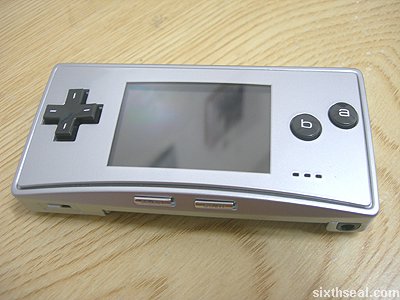
This is the Game Boy micro handheld unit. The Game Boy micro is made of aluminum metal and looks like brushed silver. It looks good for a handheld – small and sleek. The LCD screen is incredibly bright with high resolution due to its smaller dimensions from a GBA unit (which are the games you would be playing with the Game Boy micro). The simple D-pad with A and B buttons is perfect – back to minimalist handheld gaming.
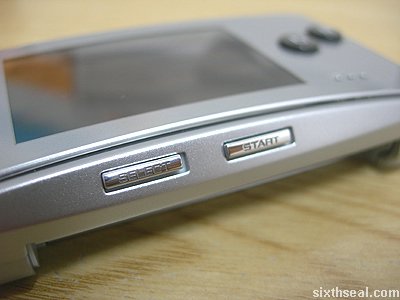
There is also a Start and Select button on the bottom of the Game Boy micro unit. It flashes blue for several seconds if it’s on a full charge and goes dormant (same color scheme occurs during the charging process – the Start and Select buttons go blue during charging and goes dormant when it’s fully charged). The two buttons goes red when the Game Boy micro unit is low on battery. The Start and Select buttons should be familiar to gamers. The On/Off toggle switch is also located at the bottom of the GBM.

The top of the Game Boy micro unit is built in with the receptacle that accepts the AC Adapter included with the Game Boy micro unit. This placement is crucial, as I found out, as it allows gaming even when the unit is being recharged (and this is very important for long RPG’s like Final Fantasy IV for the GBA – there is a problem with saving games and you basically have to go through the game in one shot). There are also Left and Right buttons at the top. It’s all very intuitive for console and handheld gamers.

This is the back of the Game Boy micro unit. The bottom of the unit accepts the game cartridges. The Game Boy micro is compatible with all Game Boy Advance (GBA) and Game Boy Advance SP cartridges. That’s a huge library of games at your disposal. However, the cartridges are expensive though – it would be cheaper to get one of the aftermarket GBA cartridge converters that accepts an SD Card – which you can use to download ROM’s for the GBA online and transfer it into the SD Card for gaming on the go (beats playing it on an emulator on the PC any day). Please note that this is illegal if you do not own the original copy of the GBA game though. 😉

Here is a comparison to show the actual size of the Game Boy micro – it is pictured here with a normal King Size cigarette box (20’s). It is only slightly longer than the cigarette box. The official dimensions for the Game Boy micro is 4 inches by 2 inches. It’s the smallest handheld unit on the market.
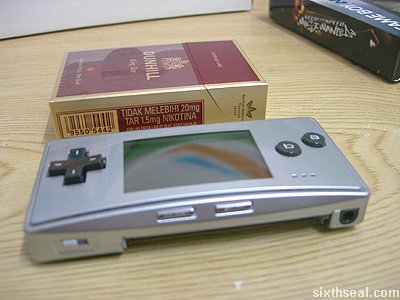
This is a picture to compare the thickness of the Game Boy micro. It’s hardly near the bulk of the cigarette box – the Game Boy micro measures 0.8 inches in depth. The cartridge adds minimal bulk to the unit, which is surprising. The Game Boy Advance and Game Boy Advance SP cartridges all fits in snugly with minimal outcrop.
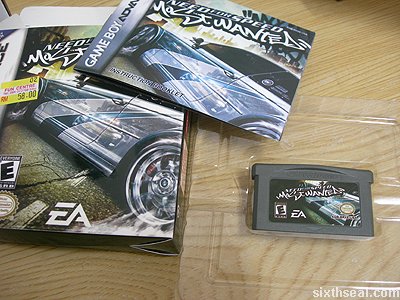
I bought Need for Speed: Most Wanted for the GBA bundled with the game. The Game Boy micro does not have a library of its own – it takes in GBA and GBA-SP cartridges for games.

This is how the cartridges are slotted into the Game Boy micro. It has an auto-interlock system for safe insertion of the cartridges and the raised portion of the cartridges allows you to pull out the cartridges instead of depending on a push-out button, which minimizes mechanical failure during constant swapping of cartridges.

Here is the Game Boy micro with Need for Speed: Most Wanted for the Game Boy Advance. The GBA cartridges all slots in with minimal outcrop, which is great for pulling out cartridges and inserting them.

This is the Game Boy micro boot up screen – it shows the Nintendo Game Boy micro boot up sequence (video below) and the Select and Start buttons are red – indicating low battery status.

Download: Game Boy micro (GBM) boot up sequence video [sixthseal.com]

Here is the Need for Speed: Most Wanted splash screen on the Game Boy micro. The LCD screen is incredibly bright and has a very high resolution compared to the GBA (first and second editions), partly due to the smaller LCD screen, which compresses the pixels. I was impressed by the clarity of the screen on the Game Boy micro.

This is how Need for Speed: Most Wanted looks on the Game Boy micro. The rendering is impressive on a handheld of the Game Boy micro generation (GBA). I was interested in how a racing game would perform on a Game Boy micro and it performs much better than on the original platform (GBA) – probably due to the faster processor.

Download: Need for Speed: Most Wanted game play movie [sixthseal.com]

The faster processor on the Game Boy micro can also lead to problems with classic GBA games…Final Fantasy IV Advance runs much faster than I remembered on the Game Boy micro compared to the Game Boy Advance SP. The graphics and the sound has depth to it though – much more than the GBA. The tests were run with a self-powered headphone attached to the stereo jack – the sound output is dismal on a stock Game Boy micro.
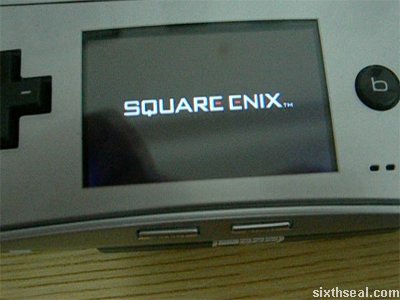
Download: Final Fantasy IV Advance on Game Boy micro [sixthseal.com]
The Game Boy micro is a great handheld system for classic games though – the return to the basic D-pad and the A and B buttons with a higher resolution and brighter LCD screen and the sleek form factor just cannot be beat at this price range.
I’ll give the Game Boy micro two thumbs up but one of them is on the directional pad and the other on the A button. 😉
]]>